Motorola Announces The Moto Z And Moto Z Force
by Matt Humrick on June 9, 2016 11:30 PM EST- Posted in
- Smartphones
- Motorola
- Mobile
- Snapdragon 820
- Moto Z
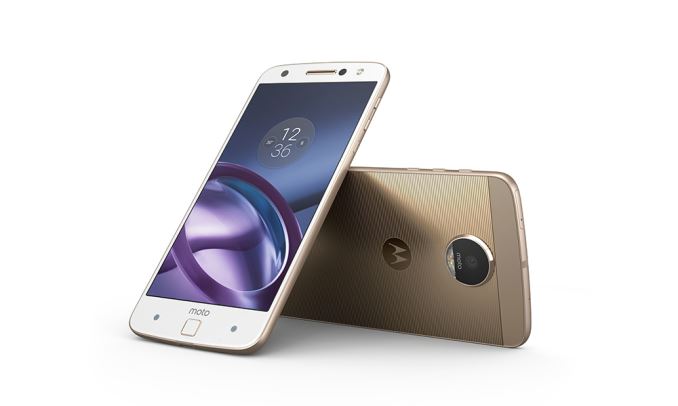
Today at Lenovo’s Tech World event, Lenovo and Motorola announced a plethora of new products, including two new smartphones, the Moto Z and Moto Z Force, which replace the Moto X Play and Moto X Style/Pure Edition at the upper end of its lineup. As the change in letter designation suggests, these new phones differ significantly from Motorola’s previous offerings in both design and function, in addition to the usual hardware upgrades.
Both Z models share much of the same hardware. They both use Qualcomm’s Snapdragon 820 SoC, with four custom Kryo CPU cores running at up to 2.15GHz and an Adreno 530 GPU, paired with 4GB of LPDDR4 RAM—the same formula most current generation flagship phones are using. Both models offer two storage options based on UFS 2.0 NAND, 32GB and 64GB, and support storage expansion with a microSD card.
| Motorola Moto Z Family | ||
| Moto Z | Moto Z Force | |
| SoC | Qualcomm Snapdragon 820 (MSM8996) 2x Kryo @ 2.15GHz 2x Kryo @ 1.59GHz Adreno 530 |
Qualcomm Snapdragon 820 (MSM8996) 2x Kryo @ 2.15GHz 2x Kryo @ 1.59GHz Adreno 530 |
| RAM | 4GB LPDDR4 | 4GB LPDDR4 |
| NAND | 32GB / 64GB (UFS 2.0) + microSD |
32GB / 64GB (UFS 2.0) + microSD |
| Display | 5.5-inch 2560x1440 AMOLED Corning Gorilla Glass |
5.5-inch 2560x1440 AMOLED Moto ShatterShield |
| Dimensions | 153.3 x 75.3 x 5.19 mm 136 grams |
155.9 x 75.8 x 6.99 mm 163 grams |
| Modem | Qualcomm X12 (Integrated) 2G / 3G / 4G LTE (Category 12/13) |
Qualcomm X12 (Integrated) 2G / 3G / 4G LTE (Category 12/13) |
| SIM Size | NanoSIM | NanoSIM |
| Front Camera | 5MP, 1.4µm pixels, f/2.2, LED flash | 5MP, 1.4µm pixels, f/2.2, LED flash |
| Rear Camera | 13MP, 1.12µm pixels, f/1.8, Laser AF, OIS, Auto HDR, dual-color LED flash | 21MP, 1.12µm pixels, f/1.8, PDAF + Laser AF, OIS, Auto HDR, dual-color LED flash |
| Battery | 2600 mAh non-removable |
3500 mAh non-removable |
| Connectivity | 802.11a/b/g/n/ac 2x2 MIMO, BT 4.1 LE, NFC, GPS/GNSS, USB Type-C, Moto Mods connector | 802.11a/b/g/n/ac 2x2 MIMO, BT 4.1 LE, NFC, GPS/GNSS, USB Type-C, Moto Mods connector |
| Launch OS | Android 6.0.1 | Android 6.0.1 |
The Moto X family uses IPS LCD panels, but the Moto Z family switches to AMOLED. At 5.5-inches, they’re also slightly smaller than the Moto X’s 5.7-inch display but retain the same QHD (2560x1440) resolution, giving the new panels a pixel density of 535ppi. Motorola has not said if the new displays support a wide color gamut like most AMOLED displays or if there’s a proper sRGB mode. Motorola has been delivering some nice looking screens the past couple generations—the Moto X Pure Edition’s panel is particularly well calibrated—so hopefully this attention to detail is applied to the Moto Z.
Both Z models include a touch-based fingerprint scanner on the front and Motorola’s latest TurboPower fast-charging technology that supposedly provides up to 8 or 15 hours of battery life in just 15 minutes for the Moto Z and Moto Z Force, respectively. While neither phone is water and dust proof like Samsung’s IP68 rated Galaxy S7, they do include a water-repellant nano coating that helps protect them from accidental spills or light rain.
Like the Moto X Pure Edition, the Moto Z models have 5MP front-facing cameras with a dedicated flash. Around back, the Moto Z uses a 13MP sensor with laser assisted autofocus paired with an f/1.8 lens and optical image stabilization (OIS) to help improve low-light performance. The Moto Z Force also includes an f/1.8 lens and OIS, but increases resolution to 21MP and upgrades to a hybrid autofocus system that combines phase detect autofocus (PDAF), laser AF, and traditional contrast-based AF as a fallback to improve focus speed and accuracy. The Moto X Pure Edition also has a 21MP rear camera with PDAF, but it appears the Moto Z Force is not using the same Sony IMX230 Exmor RS sensor. Instead, Motorola is using a new sensor that adds Deep Trench Isolation (DTI) technology to improve color fidelity.
Motorola uses a similar design language and materials for both Moto Z models, fusing an all-aluminum chassis with edge-to-edge cover glass on the front. The antennas appear to be located behind plastic inserts on the top and bottom of the back panel, but we will not know for sure until we’ve had a chance to see the phones in person.
While Corning’s Gorilla Glass protects the Moto Z’s screen, the Moto Z Force uses second generation Moto ShatterShield technology to further protect the screen from cracking or shattering if dropped. A five-layer system, Moto ShatterShield uses an aluminum panel below the AMOLED screen to keep it from flexing. A dual touch layer provides redundancy in case one of the touch layers is damaged. Finally, two separate lenses, one of which is likely polycarbonate, provide resistance to cracking and scratching, which is backed by a four-year warranty.
The phone’s earpiece doubles as a mono front-facing speaker, which leaves only the USB Type-C port on the bottom edge. If you look closely, you’ll notice that there’s no 3.5mm headphone jack; the Moto Z uses the Type-C port for audio. This will surely be a divisive decision, but Motorola is at least including a 3.5mm to Type-C port headphone adapter. Of course, using the adapter means you cannot listen with headphones and charge the phone at the same time.
The relatively large lower bezel is also a concern, because it may further limit the ability to reach the upper portion of the screen and to comfortably use the onscreen keyboard. Motorola’s decision to use a square fingerprint sensor is partly to blame, but it also looks like the display’s control circuitry is sitting behind the “moto” logo below the screen. This less than advantageous placement is probably the result of the Moto Z’s razor-thin chassis.
The Moto Z is only 5.19mm thick, while the Moto Z Force is just under 7mm thick. There’s a reason why Motorola opted for such a thin design, which I’ll discuss in a minute, but first we need to consider the other side effects of the Z’s slim chassis. The most obvious is how far the rear camera module protrudes from the back. The more serious issue, however, is the impact on battery capacity. Motorola was able to squeeze a 3500 mAh battery into the Moto Z Force’s thicker body, but at 2600 mAh, the Moto Z has a relatively small battery for a phone with a 5.5-inch display and high-end SoC, leading to concerns about battery life.
So why did Motorola push for such thin designs? Because of its modular accessories it calls Moto Mods that snap into place on the back of the phone using strong magnets. These accessories all add additional thickness to the phone, so eliminating unnecessary bulk was a priority. Initially, there will be a range of real wood, leather, and fabric patterned decorative backplates that sit flush with the rear camera when snapped into place. There’s also the JBL SoundBoost speaker that adds two 27mm diameter, 3W speakers; a built-in kickstand for propping up the phone; and an additional 1000 mAh battery, along with the Moto Insta-Share Projector, which outputs a 854x480 WVGA image at 50 lumens nominal using DLP technology. Incipio’s Offgrid Power Pack adds a 2220 mAh battery and the option to add wireless charging support.
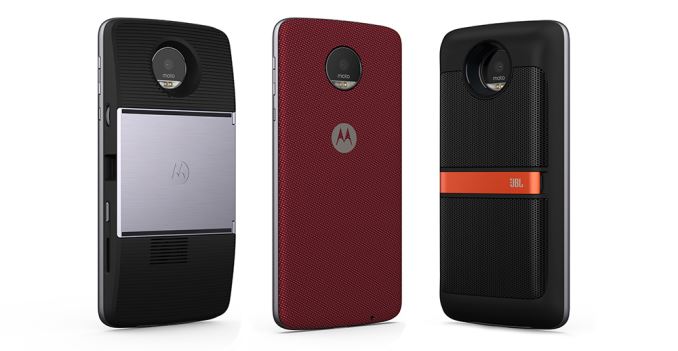
Moto Insta-Share Projector, Style Shell, JBL SoundBoost speaker
Motorola says the Moto Mods are automatically recognized when snapped on and only require a one-time setup process. Unlike with LG’s modular G5, the Moto Z does not need to be rebooted when swapping modules, which is a definite plus. Also, Motorola says that Moto Mods will be compatible with future generation phones, although how far this will extend is unknown.
In the U.S., both phones will initially be Verizon exclusives under the DROID brand. The Moto Z DROID Edition and the Moto Z Force DROID Edition will be available this summer along with the Moto Mods announced today. The Moto Z will be available unlocked this fall from moto.com and various retailers. There will also be an international version of the Moto Z available in September. Pricing has not been announced yet.


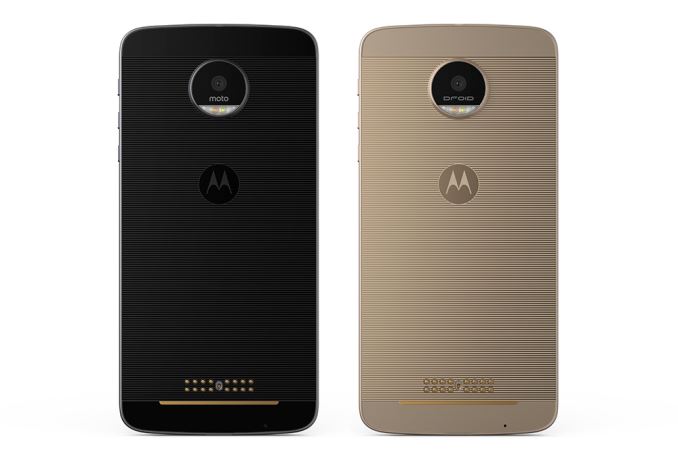
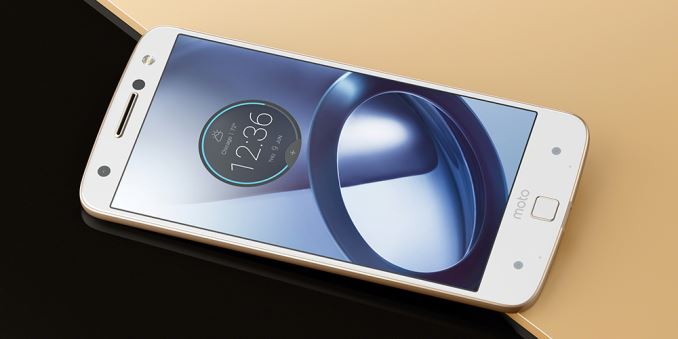
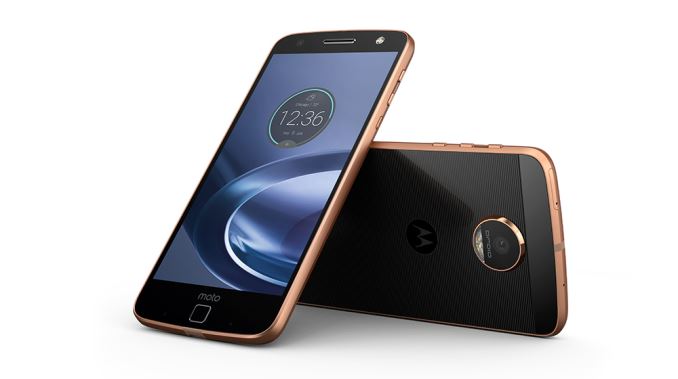
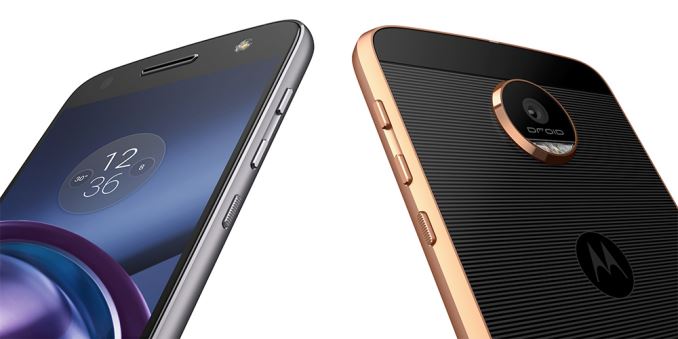








84 Comments
View All Comments
Michael Bay - Friday, June 10, 2016 - link
Because the use case for proles has shifted. They don`t use their goddamn phones for talking anymore, no, it`s all faceberg and insultingly dumb games.Murloc - Friday, June 10, 2016 - link
people do get used to the bigger screens, and women and neapolitan men have purses to put them in anyway so size is not an issue.micksh - Friday, June 10, 2016 - link
Size is still an issue, even for internet browsing/reading. Hands hasn't grown larger. 4.7" phone can be operated with one hand, 5.5"+ phone cannot.Exodite - Friday, June 10, 2016 - link
I'm not convinced that it's relevant for that large a number of users.It's a common enough argument but to me that always sounded like gibberish. While I do use a smaller device, an Xperia Z3 Compact, I've never used any device with one hand and I don't see how you reasonably could for anything but voice calls.
Obviously, for users who don't use their phones one-handed regardless the inability to use a device with one hand isn't a particularly strong con.
micksh - Friday, June 10, 2016 - link
Most often I use smartphone to browse web, read RSS, facebook, etc. I can do lots of things with one hand on Z3 Compact, even type short messages.If you can't use phone with one hand, you, for example, can't eat while learning something from internet. That's wasting of time. Having to use both hands severely limits smartphone usage. Another example - you can't use it while standing in public transit and holding a hand-rail.
I doubt that 4.7" iPhones outsell big ones by so wide margin only because of 100 bucks price difference.
Exodite - Friday, June 10, 2016 - link
I suppose it's mainly because my usage contain more writing than simply reading.It's not /impossible/ to do, it's just not particularly efficient.
As for the iPhone that's an entirely different can of worms, I don't think the platforms can be compared on size alone.
Impulses - Sunday, June 12, 2016 - link
I write as fast with one hand as a ton of people do with two... If you learn Swype's shortcuts it's every bit as efficient.Chidoro - Sunday, June 12, 2016 - link
Most people purchase the 16 gig model, do most prefer 16 to 64? Of course not. Price is a big issue when your phone starts at $649. You also have to consider that iPhone users all had dinky 4 and 3.5" screens. I'm sure many would see the jump from those a to a 5.5" as too big a difference. Besides, the big iPhone as particularly big compared to other phones with 5.5" screens.Impulses - Friday, June 10, 2016 - link
" I've never used any device with one hand and I don't see how you reasonably could for anything but voice calls. "Wow, I can tell you flat out that's a very inaccurate misconception. I've had all three HTC EVOs followed by my current phone, a Nexus 5, and I can guarantee you my usage of them is 90% one handed, for EVERYTHING. Browsing, texting (Swype pretty much promotes one hand use), whatever.
Gaming might be the only thing that requires two hands and I don't do much of it. Maybe I'm in a minority, I dunno, but I don't have any freaky natural abilities that enable this usage. I'm your average 5'11" 160 pound male... I have my phone in my left pocket, I slip it out with my left hand, and I use it largely with that hand alone even tho I'm right handed (can use it with either tho).
I think people that never use their phone with one hand have probably never tried a swiping style keyboard (and learned the necessary swipe shortcuts and gestures for capitalization etc), if you need to constantly hunt and peck with two thumbs then yeah, you need two hands.
If I went any larger than the N5's 5.2" screen (and relatively minimal bottom bezel) I'd definitely struggle tho, cause I'd need to adjust my grip to reach the notification bar, even now it's a tiny bit of a stretch and I wouldn't mind slightly smaller or less bezel. My grip has my pinky supporting the phone from below which enables my large-ish thumb more freedom of motion than if I palm the phone against the center of my hand.
Like others said, eating, commuting, etc; there's a million usage cases why I prefer one handed use.
Impulses - Friday, June 10, 2016 - link
Wrote this whole message with one hand btw.